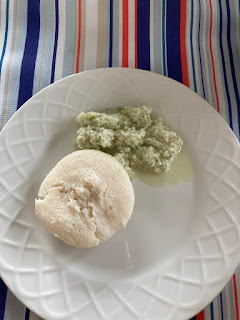Idlis - light, soft, fluffy and the closest to what you get in south India
Light, soft, fluffy Idli's - no baking soda or other additives
(takes 2 days due to fermentation duration)
- 2 cups Urad daal
- 1 cup Idli Rava (rice powder that's coarsely ground - buy it from the Indian grocery store)
- For fluffiest idlis - Urad:Rice ratio is 1:2. Then add 1/2 tsp of Eno fruit salt right before you steam the idlis
- For medium fluffy idlis - Urad:Rice ratio is 1.5 : 2.
- If you're concerned with carbs, go for the Urad:Rice ratio of 2:1. Not as fluffy but more filling and you'll eat fewer carbs
- Instant Pot - this is a critical tool in this recipe for the fermentation stage
- 2 tsp plain yogurt
- Salt
- Idli stand - get the stainless steel one with 4 per layer
- 1 tbsp coconut oil to grease the idli pans
- 1 pot with lid such that the idli stand fits into it and you can put the lid on. This is used for steaming the idlis.
This recipe makes 24 idlis.
Note - the process is a 2-day process so don't expect instant results. Patience pays off in this recipe.
I have tried, in vain, over the last 30+ years to make decent (closest to what you get in south India) Idlis and have consistently failed. Sometimes, catastrophically. This recipe is the first that I've come up with that actually worked and the idlis are soft, fluffy and light - almost like the ones in south India (IMO, you cannot get that quality anywhere in the world except south India, that too, only in certain places/restaurants and people's homes).
The key to good idlis is the batter texture (how much to grind the daal), the fermentation and an Idli stand that works.
Batter texture: Slightly thicker than pancake batter but not as thick as cake batter. That's the most apt description I can think of for people not familiar with Idli batter. Or you can buy a tub from your local Indian store the first time and use that. It'll give you an idea what the batter consistency should be. Make sure you don't buy Dosa batter since it's thinner.
Process
Soak urad daal and rice power SEPARATELY for a minimum of 1.5 days. Then grind the urad daal - it takes me about 2 min in my Ninja grinder (normally slated for smoothies). Watch the amount of water keeping in mind that you can always add more later but cannot subtract - so going with a thicker batter is a good thing. Mix the ground urad daal with the soaked rice powder and just enough water to attain the consistency stated in the "Batter Texture" above.
Add yogurt to the batter and mix well (do not add salt at this stage). Pour the batter into your IP, cover (venting mode) and hit the "Yogurt" setting. Leave overnight for fermentation or approximately 10 - 12 hours. Note that if you live in a location that is hot/warm, this can be done by leaving the batter (covered) in the sun or a hot place for about 4-5 hours. If you see that the batter doubles or close to that, you're good to go.
In the steamer pot (see above for description), pour a cup of water and bring to a boil.
Grease the idli molds with coconut oil (don't need much - just enough so the idlis don't stick), add salt to the batter + stir and pour the batter into the idli molds. Put the molds onto the stand and make sure it's sturdy. If you don't have enough batter for a particular level, fill the empty molds with water. Be careful carrying/placing into the steamer pot. Place idli stand into the steamer pot.
Steam for 15 min.
Remove idli stand from steamer pot and let it rest for about 5 min. It's very hot and the idlis are prone to breaking if you try to unmold them when they're very hot. Once the cool off a bit, unmold the idlis and enjoy.
I usually like to eat them with fresh coconut, peanut, green chilli, curry leaf chutney. Will post recipe for that later. If I have sambar, that's an added luxury.






Comments
Post a Comment